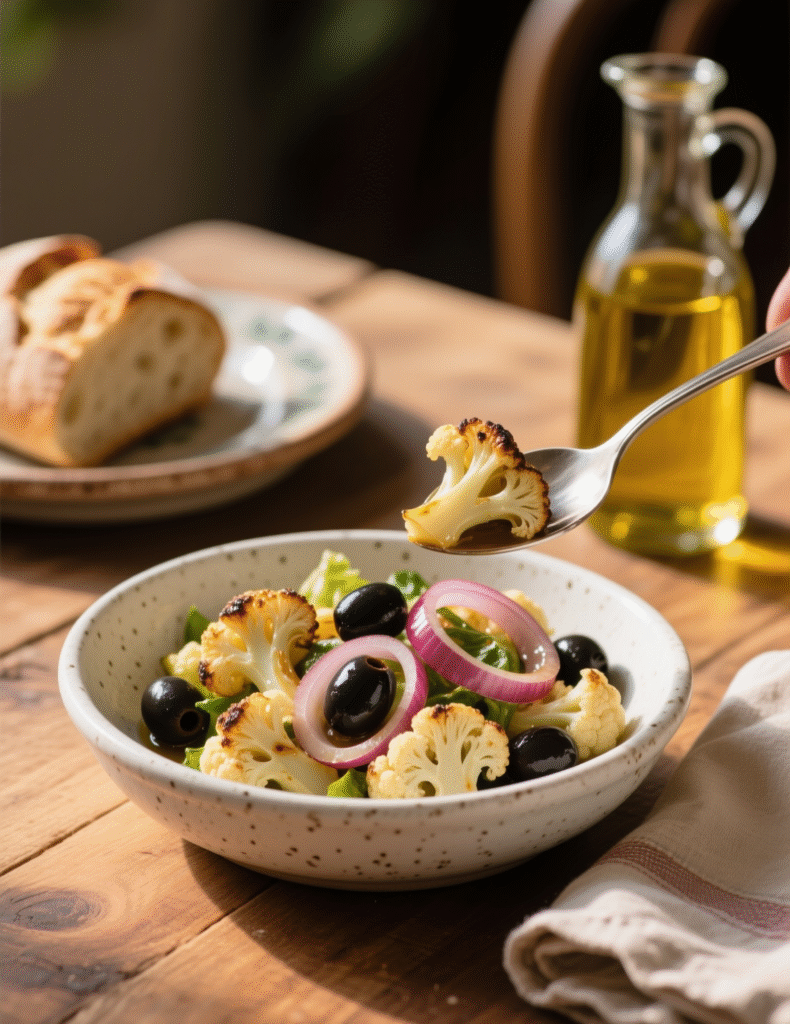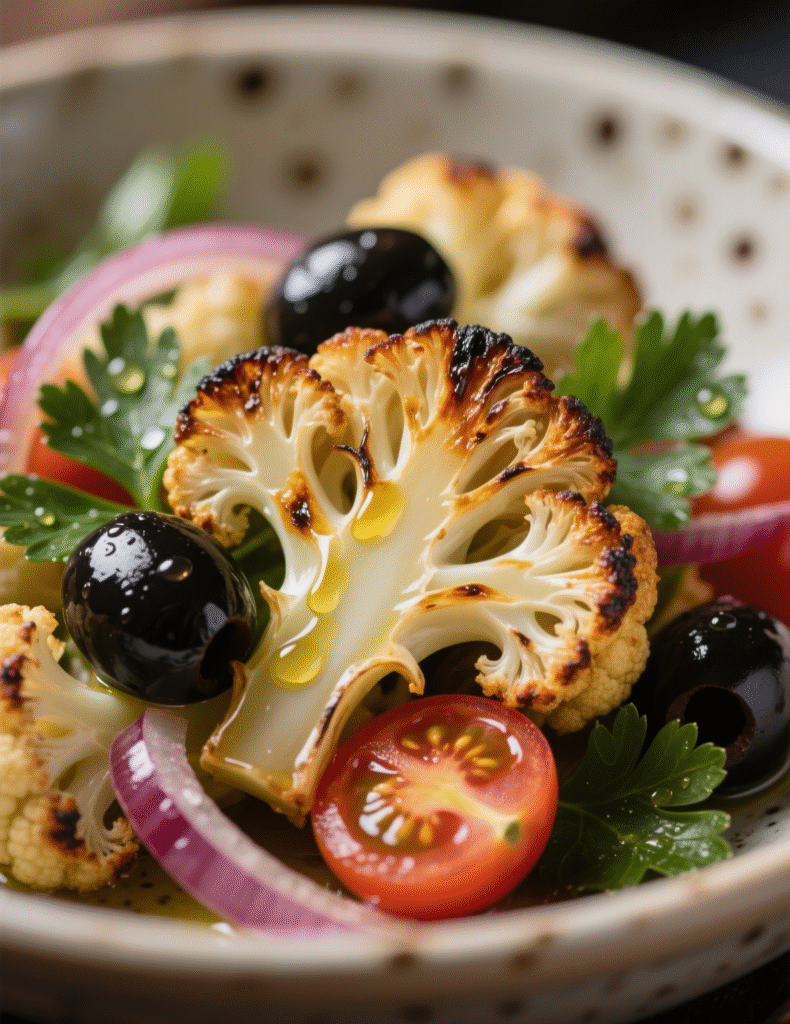Cauliflower is one of those vegetables that hides in plain sight. Ordinary looking, but when it meets the Sicilian kitchen it turns into something dazzling. The Sicilian cauliflower salad recipe is not just food—it’s a piece of history, culture, and a masterclass in balance of flavors. This dish is simple, yes, but it carries layers that only Mediterranean tradition can carve into vegetables.
Why Sicilian Cauliflower Salad Matters
Sicily isn’t only about arancini or cannoli. The island is shaped by centuries of Greek, Arab, and Spanish influence. That mixture shows up most clearly in salads, where humble vegetables like cauliflower are elevated with citrus, olives, herbs, and nuts.
Cauliflower salad here is not the bland steamed kind you’ve seen at a potluck. It’s bright with lemon, earthy with olive oil, briny with capers, and sometimes sweet with raisins or pine nuts. This balance of sweet, sour, salty, and nutty is very Sicilian—what they call agrodolce.
Chefs who work with Mediterranean flavors know this: dishes are rarely just about filling the stomach. They aim to reset the palate, to refresh the diner, to bring a breeze of the sea right to the table.
The Role of Cauliflower in Sicilian Cuisine
Cauliflower grows easily in Sicily’s mild winters. It’s cheap, abundant, and versatile. Street markets in Palermo or Catania overflow with giant heads of purple, white, or even green cauliflower.
What makes it special is how locals treat it. Instead of boiling it to mush, they blanch, roast, or steam it just enough to keep bite and structure. Then it gets dressed like royalty—with olive oil that actually tastes of olives, lemons pulled that morning, and anchovies that bite back.
A fun detail: cauliflower is often called broccolo in Sicily, which confuses outsiders who expect broccoli. So if you order a salad with broccolo, don’t be surprised if a cauliflower arrives instead.
Essential Ingredients for Authenticity
Professional kitchens thrive on precision, and here every ingredient matters.
- Cauliflower: Firm, fresh, preferably organic. Romanesco works beautifully too.
- Extra virgin olive oil: No compromises here. Sicilian olive oil is peppery and green—use it if possible.
- Citrus: Lemon is classic, but blood orange appears in some regional versions.
- Capers: Salt-packed capers from Pantelleria are the gold standard. Rinse them well.
- Anchovies: Not optional if you want real Sicilian character. They melt into the oil, leaving umami depth.
- Herbs: Flat-leaf parsley, sometimes mint.
- Sweet element: Toasted pine nuts or golden raisins, a legacy of Arab influence.
Balance is the secret. If the salad tastes only sour, you’ve failed. If it’s only sweet, it’s not Sicilian anymore.

Step-by-Step Method
Preparing the Cauliflower
Cut the cauliflower into small florets. Keep them uniform so they cook evenly. Blanch in salted boiling water just until tender, around 3–4 minutes. Drain quickly and cool. They should still snap when bitten.
Some chefs roast instead. High heat, olive oil drizzle, 15 minutes at 425°F. This caramelizes edges and deepens flavor. It’s less traditional, but modern Sicilian restaurants use it often.
Building the Dressing
In a pan, warm olive oil gently with garlic and anchovy fillets. The anchovies dissolve into the oil, creating a savory base. Add capers and a squeeze of lemon.
The dressing must be warm when poured over the cauliflower. Warm oil opens the cauliflower fibers, letting flavor seep inside. Cold dressing? It just sits there, lifeless.
Assembling the Salad
Toss cauliflower with dressing, toasted pine nuts, raisins (if using), and fresh parsley. Taste. Adjust salt and acid. It should zing but also linger with a sweet echo.
Finish with extra olive oil on top. Some chefs add a scattering of chili flakes for heat.
Professional Insights on Technique
Timing is everything. Overcooked cauliflower turns sulfurous, an instant dealbreaker. Michelin-trained chefs often blanch in heavily salted water (as salty as the sea) for just under 3 minutes, then shock in ice water. That stops cooking but preserves structure.
Another trick: toast pine nuts in a dry pan slowly, until they smell nutty but not burnt. Burnt nuts ruin the salad, period.
Capers demand rinsing. Salt-packed capers should be soaked for 10–15 minutes in cold water. Otherwise, your salad becomes a salt bomb.
Anchovies scare some cooks, but in professional kitchens they’re not negotiable. Think of them like seasoning, not fish. They vanish into oil, leaving nothing but a deep, savory backbone.
Variations Across Sicily
Palermo favors raisins and pine nuts, a sweet touch echoing Arab legacy. Catania leans heavier on chili flakes and anchovies, stronger flavors reflecting the volcanic landscape.
Some coastal towns add orange segments instead of lemon, turning the salad slightly sweeter. Inland villages keep it simpler—just cauliflower, olive oil, lemon, and parsley.
The variety reflects Sicily’s geography: mountain, sea, fertile plains, volcanic soil. All shaping what grows, and what ends up in the bowl.

Nutritional Powerhouse
Cauliflower is high in vitamin C, vitamin K, and fiber. Olive oil contributes healthy monounsaturated fats. Anchovies bring omega-3s, while nuts add protein and minerals.
A 1-cup serving of Sicilian cauliflower salad averages about 160–180 calories. It’s nutrient-dense without being heavy. Perfect as an antipasto, side dish, or even a light main course for lunch.
Dieticians often recommend Mediterranean diets for heart health. This salad checks every box: fresh vegetables, healthy fat, balance of nutrients. It’s no accident people in Sicily live longer than most Europeans.
Common Mistakes to Avoid
- Overcooking the cauliflower: makes it watery and dull.
- Skipping anchovies: removes the umami punch.
- Using poor olive oil: turns the salad flat.
- Adding too much lemon juice: overwhelms balance.
- Serving straight from fridge: the flavors close up when cold. Always serve at room temperature.
Professionals know that the simplest dishes are the hardest to master. There’s nowhere to hide mistakes.
Pairings and Serving Suggestions
This salad shines as a starter. Pair with grilled swordfish, roasted chicken, or even lamb. Sicilians often serve it alongside pasta con le sarde, another iconic dish with similar sweet-salty notes.
Wine pairing matters. A crisp Grillo or a mineral-driven Etna Bianco works beautifully. The acidity in the wine matches lemon in the salad, while the minerality echoes capers and anchovies.
Bread is essential. A rustic Sicilian loaf, torn and dipped in leftover dressing, might be the best part of the meal.
Emerging Trends and Modern Twists
Modern chefs are riffing on this salad. Some roast cauliflower whole and carve it tableside, dressing with Sicilian flavors. Others fold it into farro or couscous for a heartier dish.
Plant-based restaurants swap anchovies for miso paste, which brings umami without fish. It’s not traditional, but it keeps the spirit alive.
Fine dining kitchens sometimes plate deconstructed versions—cauliflower purée, fried florets, citrus gel, caper dust. But even in its fanciest version, the soul of the dish remains intact.
Historical and Cultural Layers
The salad reflects centuries of culinary exchange. Arabs brought citrus, raisins, and nuts. Spaniards influenced the love of capers and anchovies. Greeks gave Sicily olive trees that still thrive today.
Every bite carries those layers. It’s not just food—it’s a living memory of empire, trade, and adaptation. No wonder UNESCO lists Mediterranean diet traditions as intangible cultural heritage.
Conclusion: Why This Recipe Still Resonates
The Sicilian cauliflower salad recipe isn’t just another Mediterranean dish. It’s a symbol of how simple ingredients, treated with respect, can become extraordinary. Professionals love it because it demands precision. Home cooks love it because it delivers bold flavor with little effort.
If you take one thing away, let it be this: treat cauliflower with respect. Don’t drown it, don’t suffocate it, let it breathe. Pair it with ingredients that shine on their own, but when combined, create harmony.
And maybe that’s the real lesson here—Sicilian cooking isn’t about complication. It’s about knowing when to stop.
FAQs
What is Sicilian cauliflower salad?
It’s a traditional Sicilian dish made with cauliflower, olive oil, citrus, capers, anchovies, and sometimes raisins or pine nuts.
Why is cauliflower important in Sicilian cuisine?
It grows abundantly in Sicily’s climate and is used in many seasonal dishes, often called broccolo locally.
Can I make it without anchovies?
Yes, but anchovies add umami depth; some modern versions use miso paste instead.
Should cauliflower be boiled or roasted?
Traditionally it’s blanched, but roasting adds a modern twist with caramelized flavor.
How do I stop cauliflower from overcooking?
Blanch it in salted water for 3 minutes and shock in ice water to keep it firm.
Do I need to rinse capers?
Yes, especially salt-packed ones, or the salad will be overly salty.
Is this salad healthy?
Absolutely, it’s rich in vitamins, fiber, omega-3s, and healthy fats from olive oil.
Can I serve it cold?
Better to serve at room temperature, since cold dressing dulls the flavors.
What wines pair well with this salad?
Crisp Sicilian whites like Grillo or Etna Bianco complement it beautifully.
What’s the biggest mistake people make?
Overcooking the cauliflower, which destroys both texture and flavor.

Mariana is a passionate home cook who creates delicious, easy-to-follow recipes for busy people. From energizing breakfasts to satisfying dinners and indulgent desserts, her dishes are designed to fuel both your body and hustle.
When she’s not in the kitchen, she’s exploring new flavors and dreaming up her next recipe to share with the Foodie Hustle community.

